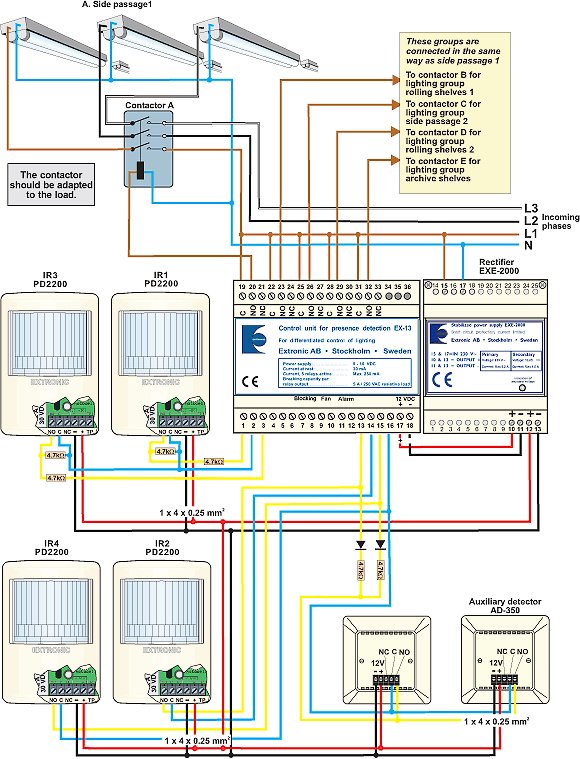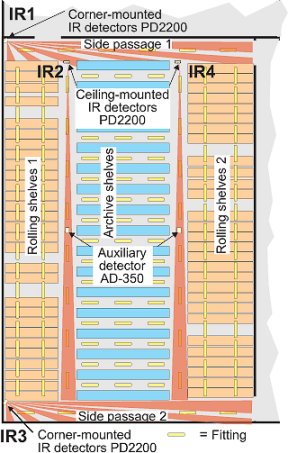6B. Archive with IR detectors, acoustic auxiliary detectors and EX-13 logic module
50 Hz or non-dimmable and dimmable HF operating devices and ‘dynamic lighting control’
Svenskt patent nr. 9201493-5, English patent No. 0659329
| The premises
This example shows an archive with roller shelves and fixed archive shelves with passages in between. Light sources The fittings in this storage facility can be 50 Hz with choke operation, or non-dimmable or dimmable HF operating devices with analogue control (1 – 10 V). Control system Presence in the isles is detected using IR detectors that activate the lighting. The lighting remains on in the event of continued detection by the IR detectors and with the aid of AD-350 acoustic auxiliary detectors. Two auxiliary detectors listen for high-frequency sound, and in the event of detection they keep the lighting on even if the IR detectors do not detect any movement. The EX-13 logic module is programmed to switch on various lighting groups, depending on which detector(s) detect(s) presence as follows: IR detector 1 switches on side passage 1. Positioning of the detectors In the side passages the detectors are corner-mounted at the short ends of the passages. See application example 2A for positioning of the detector. Presence detection in warehouse passages will ideally use a special solution. The PD-2200 detector with Lens No. 17 is mounted at an angle of 45° to the cornerpost’s plumbline, with the ‘foot’ against the post. One detector copes with detection in warehouse passages up to 50 m long. By using Lens No. 17 and turning the detector through 90° optimum detection can be attained in warehouse passages, archives etc. Individual fields in the lens system can be screened off so that fields do not reach areas where no detection is to take place. Acoustic auxiliary detector The AD-350 is an acoustic detector that only listens to a limited frequency range between approx. 3 and 7 kHz, which is then analysed by a microprocessor. In the event of sound detection within this frequency range the built-in variable relay switches on. The relay will remain switched on during the detection period plus the time set on the built-in timer. The AD-350 switches the lighting on when sound within the given frequency range is detected. The lighting is kept on for as long as sound is detected (steps, talking etc.) plus the set time delay. Since the detector’s principle of operation is based on sound, it can ‘detect around corners’ and in areas with screening interior fittings. In this application example the AD-350 is principally used as an auxiliary detector to keep the lighting switched on for as long as sound is detected. Every influence by the sound detector or IR detector prolongs the time by the time set in the relevant detector. All detectors are connected to an auxiliary relay against load/contactor to avoid 230 VAC entering the detectors. Installation of the detectors should use the simplest possible cable, e.g. EKKX 1 x 4 x 0.25 mm2. The same power supply can be used in up to 10 warehouse passages, depending on line lengths and positioning. |
Correct adjustment of the IR detectors is greatly simplified if the BL-1 field-indication diode (Order No. 13035) is used. This particularly applies in long warehouse passages. When warehouse passages are periodically used very frequently, i.e. when there are a lot of transits, installation of dynamic lighting control must be selected. This means fittings with dimmable HF operating devices, presence detection and level selectors. Dynamic lighting control provides the following function: The most important advantages attained using Dynamic Control are as follows:
See connection example below Information for current budget
|
||||||||||||||||||||||
 |
|||||||||||||||||||||||







